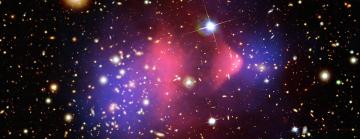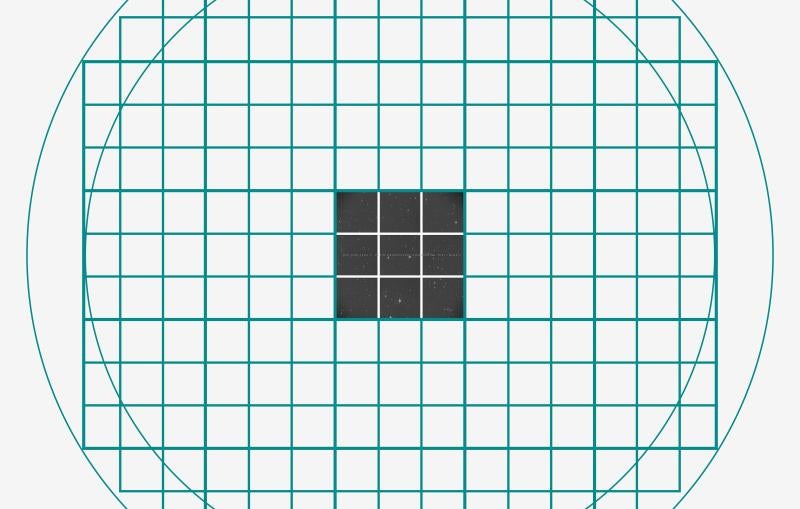New analysis of SuperCDMS data sets tighter detection limits for dark matter
The reanalysis considered new types of particle collisions and how dark matter particles interact with the Earth. While it didn’t reveal dark matter interactions, it set stricter limits for future detection.
By Kimberly Hickok
For nearly a century, dark matter has continued to evade direct detection, pushing scientists to come up with even more creative methods of searching. Increasingly sensitive detection experiments are a major undertaking, however, which means scientists want to be sure they analyze data from these experiments in the most thorough and robust way possible.
With that in mind, the Super Cryogenic Dark Matter Search (SuperCDMS) collaboration has published a reanalysis of previously published experimental data. Their study, published recently in Physical Review D, describes the team’s search for dark matter via two processes called Bremsstrahlung radiation and the Migdal effect.
In a first-of-its-kind analysis, the team also worked with geologists to consider how the Earth’s atmosphere and inner composition interact with dark matter particles to cause their energy to dissipate. The analysis represents one of the tightest limits on dark matter detection yet and sets the stage for future dark matter searches.
“As we search for dark matter, we need to extend detection sensitivities,” said Noah Kurinksy, a staff scientist at SLAC and corresponding author on the study. “Having better ways to model these processes and understand these sorts of measurements is very important for the dark matter community.”
Noah Kurinsky
SLAC staff scientist

Invisible scattering
In an experiment like SuperCDMS, physicists look for signs that dark matter has collided with the atomic nuclei – the protons and neutrons – inside a material such as silicon and germanium.
Usually, the assumption is that when a dark matter particle whacks into a nucleus, the collision is elastic: Any energy the dark matter particle loses is transferred into the motion of the nucleus, so that both particles recoil. "Your typical billiard balls scattering example,” Kurinsky explained.
In recent years, however, researchers have proposed that dark matter may be detected through inelastic collisions, in which the energy from the collision is transferred to something else that’s possibly easier to detect, such as photons or electrons. This could lead to more sensitive detection capabilities for dark matter detection experiments.
Considering that the SuperCDMS experiment is already one of the most sensitive dark matter detectors of its kind, “we wanted to know what the probability was that we see this particular type of signal in SuperCDMS data,” said Daniel Jardin, a coauthor of the new study and a postdoctoral scholar at Northwestern University who helped lead the analysis.
The team focused on two potential avenues for inelastic collisions to occur: Bremsstrahlung radiation and the Migdal effect.
Bremsstrahlung is a well-known and previously observed phenomenon caused by the deceleration of a charged particle – the word is German for "braking radiation." In a dark matter detector, this could happen when a dark matter particle collides with a nucleus, which then transfers some of its energy to a photon instead of just recoiling. If detected, that photon would suggest some mysterious, fast-moving particle – perhaps dark matter – slammed into the nucleus and sent the photon flying.
Daniel Jardin
Postdoctoral scholar at Northwestern University

Another possible mode for inelastic collisions is through the Migdal effect. Although it has yet to be experimentally demonstrated, the idea is that when a dark matter particle strikes a nucleus, that nucleus gets knocked out of the center of its electron cloud. After some very short amount of time, the electron cloud readjusts around the nucleus, ejecting electrons that researchers could detect. In recent years, scientists have calculated what such a signal would look like should it happen within dark matter detectors.
Reanalyzing the data taking inelastic processes into account didn't reveal evidence of dark matter, Jardin said, but "each of these analyses extended the experiment’s existing limits to lower masses.” A previous SuperCDMS data analysis ruled out dark matter particles with masses as low as that of the proton. Taking Bremsstrahlung into account, the experiment can now rule out dark matter particle masses down to about a fifth of the proton mass – and even lower masses when the hypothetical Migdal effect is considered.
When Earth gets in the way
But the researchers didn’t stop there. “We wanted to innovate beyond taking these ideas and applying it to our data,” said Jardin. “So, we added other things that no one else has been doing.”
Jardin and his colleagues not only extended the lowest limits of detection for dark matter interactions, but also considered the upper limit. “Researchers in the field are now realizing that if dark matter interacts strongly enough, it could interact with the atmosphere and the Earth on its way to the detector, which is deep underground. In that interaction there's actually an upper limit where you'd be blocked by the Earth itself,” Jardin said.
In particular, the more strongly dark matter interacts with other types of matter on its way to the detector, the more energy it loses. At some point, a dark matter particle could lose so much energy that by the time it reaches the detector it can no longer create a detectable signal.
To calculate the energy limit for dark matter particles reaching the SuperCDMS experiment, the researchers modeled how the densities of Earth’s atmosphere and inner layers might affect a dark matter particle pummeling through our planet to the detector. The team worked with geologists who determined the exact composition of the soil and rock surrounding the detector in the Soudan Mine in Minnesota.
With this information, the team could set upper limits for dark matter interaction strength depending on where the particle would be coming from, whether that’s directly above the detector or the other side of the Earth.
After analyzing the SuperCDMS data with the new models established by the Bremsstrahlung and Migdal effects and the new upper limits, the team was able to expand the range of particle masses the experiment was sensitive to but found no evidence of dark matter interactions. Nonetheless, the analysis represents one of the most sensitive search for ultralight dark matter and helped researchers gain more information from existing data.
“We put a lot into this experiment, so we want to get the most out of it that we can,” Jardin said. “We really don't know the mass of dark matter, and we don't know how it interacts with matter. We're just reaching out into the darkness, as best we can.”
Citation: M.F. Albarkry et al., Physical Review D, 20 June 2023 (107.112013)
For questions or comments, contact the SLAC Office of Communications at communications@slac.stanford.edu.
About SLAC
SLAC National Accelerator Laboratory explores how the universe works at the biggest, smallest and fastest scales and invents powerful tools used by researchers around the globe. As world leaders in ultrafast science and bold explorers of the physics of the universe, we forge new ground in understanding our origins and building a healthier and more sustainable future. Our discovery and innovation help develop new materials and chemical processes and open unprecedented views of the cosmos and life’s most delicate machinery. Building on more than 60 years of visionary research, we help shape the future by advancing areas such as quantum technology, scientific computing and the development of next-generation accelerators.
SLAC is operated by Stanford University for the U.S. Department of Energy’s Office of Science. The Office of Science is the single largest supporter of basic research in the physical sciences in the United States and is working to address some of the most pressing challenges of our time.






